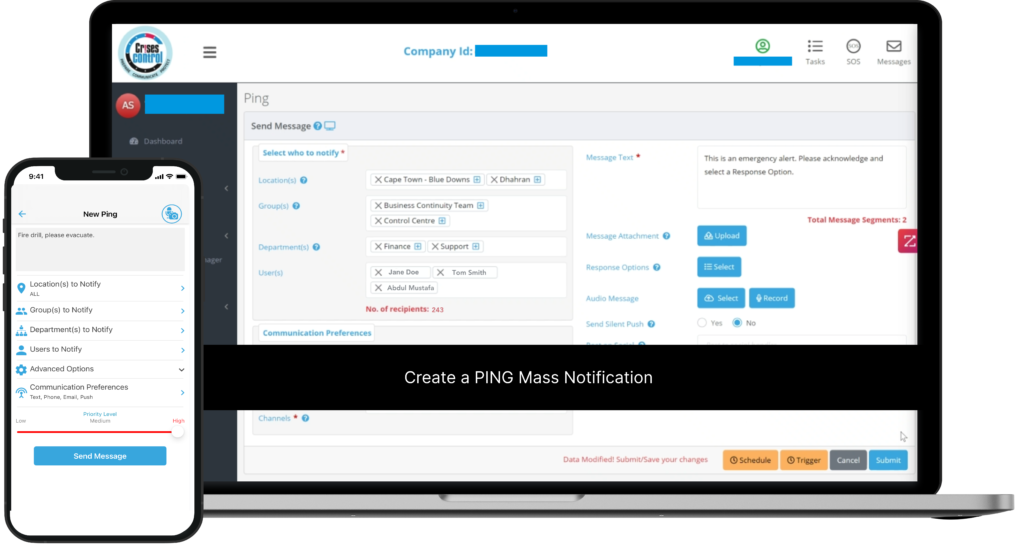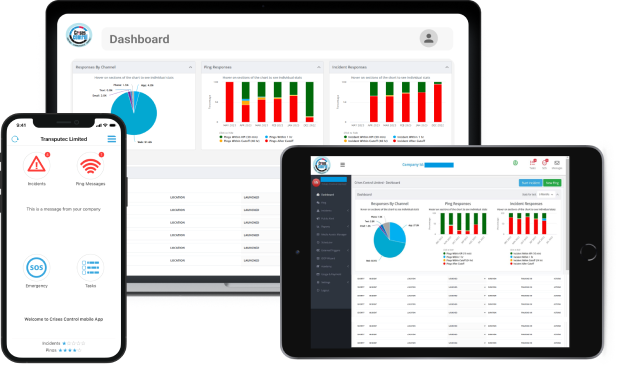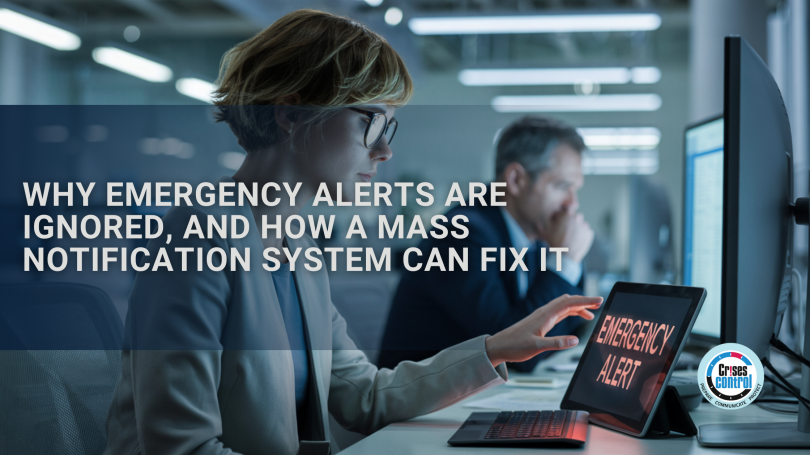Written by Anneri Fourie | Marketing Executive
Most organisations assume that when they send out an emergency alert, it’s received, read, and acted upon. But the truth? A worrying number of staff members don’t see these alerts at all, or worse, they ignore them.
If you’ve ever launched an emergency communication only to find out later that some of your team didn’t respond, or didn’t even notice it, then this blog is for you.
At Crises Control, we work with businesses every day who thought their emergency messaging was “good enough” until a missed alert exposed the cracks. Let’s unpack why this happens, what’s at stake, and how using a reliable mass notification system can turn the situation around completely.
Why Employees Ignore Emergency Alerts
There’s no single reason your alerts are being missed, but there are a few we see time and time again.
1. Alert fatigue
Staff are overwhelmed with messages all day, from Slack, Teams, texts, emails, apps. When an “urgent” message comes through, it’s easy to dismiss it as just another notification. If your emergency alerts look and feel like everything else, they’ll get buried in the noise.
2. Wrong channels at the wrong time
Sending an email alert when half your staff are away from their desks? Not effective. Sending a mobile notification to a staff member with no signal on a manufacturing floor? Equally useless. If your emergency communication platform doesn’t support multi-channel delivery, you’re likely missing key people when it matters most.
3. Lack of training or context
When staff don’t understand what an alert means or what action to take, they hesitate, or ignore it. A message saying “Lockdown now” without location context, urgency classification, or instructions may cause more confusion than clarity.
4. No feedback loop
If you can’t tell who’s received, opened, or responded to your alert, you’re flying blind. Many systems don’t provide acknowledgement tracking, which means you don’t actually know if your message was effective.
These are not theoretical issues, they’re the real-world challenges our customers face before they come to us.
What Happens When Emergency Alerts Are Missed?
The impact of missed alerts can be measured in lost time, financial damage, legal exposure, and most critically, human safety.
A logistics firm we worked with previously had a warehouse evacuation delayed by 12 minutes because staff didn’t hear the mobile-only alert.
One healthcare provider failed a compliance audit because emergency instructions were not demonstrably acknowledged by staff during a drill.
An international financial services firm couldn’t account for all employees during a building lockdown, leading to a full security review.
All of this boils down to one core issue: the message didn’t get through in time, or at all.
How to Improve Emergency Alert Response
To fix this, you need more than better wording or stronger Wi-Fi. You need a strategic shift in how your alerts are delivered, managed, and confirmed. Here’s what we recommend and what we offer at Crises Control:
1. Multi-channel, real-time emergency notifications
It’s not enough to send alerts via one channel. Crises Control’s Ping Mass Notification Module sends messages across SMS, email, push notifications, phone calls, desktop alerts and even social channels—simultaneously. This multi-layered approach ensures that if one channel fails or is ignored, others fill the gap.
2. Customisable messaging based on severity and role
Our system lets you create messages tailored to the urgency level and the recipient’s role. A facilities manager might need very different instructions from a remote worker. Clarity increases action.
3. Acknowledgement tracking and reporting
With our Incident Reporting and Audit functionality, you’ll know exactly who has received and acknowledged your alert, and who hasn’t. This allows you to follow up quickly, target additional reminders, or escalate when necessary. It also gives you a digital audit trail for compliance.
4. Automated workflows to speed up response
In high-pressure moments, you don’t want to be typing out instructions from scratch. Our automation engine allows you to pre-build scenarios for known risks, like fire, data breach, power outage, and launch them instantly with predefined messages, tasks, and escalation routes. You can also choose from over 200 incident templates in our library to accelerate your response even further.
5. Scenario testing and real-time insights
Testing your alerting process is the only way to ensure it works when you need it. Crises Control makes it easy to run drills, track responses in real time, and identify gaps before a real crisis exposes them. Through the Crises Control Academy, you can access tailored training modules and best practices to ensure your team is fully prepared to respond effectively in any emergency situation.
Interested in our Ping Mass Notification System?
Efficiently alert everyone in seconds at scale with our Mass Notification System – PING, get the message out fast and ensure rapid response and recovery.

Why Crises Control is More Than Just a Mass Notification System
It’s easy to label a product as a “mass notification system”, but what sets Crises Control apart is our end-to-end approach to incident response. We don’t just help you send alerts, we help you manage the entire lifecycle of a critical event, from detection to resolution.
Our platform is used by:
- Multinational corporations needing enterprise-level resilience
- Public sector agencies that require compliance and audit trails
- Education providers who need to reach diverse, mobile audiences
- Manufacturing and logistics firms with hard-to-reach field teams
- Oil and gas companies, ensuring safety across remote locations
- Legal firms that need secure, timely communications
- Care homes, where the safety of vulnerable people is paramount
- Aviation companies managing complex, high-risk environments
- Mines, where communication needs to be precise and immediate
And many more!
The goal is simple: make sure the right people get the right message, at the right time, and can act on it.
Improving Emergency Alert Visibility in the Workplace
If there’s one thing we tell every client, it’s this: don’t assume people are seeing your alerts.
Instead, treat visibility as a performance metric. Ask:
- How many people acknowledged the last alert?
- How long did it take from send to first response?
- Which channels got the best engagement?
- Where were the gaps, and why?
Crises Control gives you those insights in real time. Our dashboard visualises performance across geographies, roles, channels and timeframes, so you can turn every incident into a learning opportunity.
Real-Time Emergency Notifications Only Work if They’re Read
Speed is nothing without delivery. And delivery means cutting through the noise. A real-time notification is only useful if it reaches the person who needs it, and prompts them to act.
That’s why our platform focuses not just on speed, but on visibility and actionability. With Crises Control, messages are branded, prioritised, and even delivered with attention-grabbing tones and pop-ups to interrupt distractions and force attention, especially useful in busy workplaces or during remote working hours.
Choosing a Reliable Mass Alerting System: What to Look For
If you’re considering replacing your existing emergency communication setup or starting from scratch, here are the must-haves:
- Cross-channel delivery (SMS, voice, email, app, desktop)
- Recipient-level tracking and acknowledgements
- Scenario-based automation and templates
- Data privacy and compliance support
- Mobile accessibility with offline capability
- Integration with HR, ITSM, and other business systems
Crises Control offers all of the above, and our onboarding team helps tailor it to your unique organisational needs.
Final Thoughts: Don’t Let Your Next Alert Be Ignored
If you’ve made it this far, you already know that missed alerts are more than a communication issue, they’re a business risk.
Whether you’re looking to eliminate manual errors, reach dispersed teams instantly, or meet regulatory requirements, a truly reliable mass notification system is essential. And it needs to be more than a broadcast tool; it should be a smart, accountable, and integrated part of your business continuity planning.
Crises Control is built to solve exactly this problem.
Ready to see how it works?
Book a free demo today and discover how Crises Control can help you make sure no critical message ever gets missed again.
Request a FREE Demo

